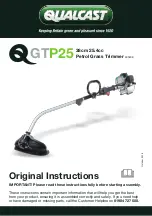
EN - 11
of them. Carry out the relevant task as
soon as it is scheduled to be performed.
•
The use of non-genuine and/or incorrectly
assembled spare parts and attachments
could adversely affect machine operation
and safety. The manufacturer shall
decline all liability in the event of injuries
or damages caused by such parts.
•
Genuine spare parts are supplied by
Authorised Assistance Centres and Dealers.
ATTENTION
Any maintenance and adjustment operations not
described in this manual must be carried out by
the local Dealer or Authorised Service Centre.
7.2 BATTERY
7.2.1
Battery power reserve
The battery power reserve mainly
depends on the following factors:
•
Environmental factors, that cause
higher energy requirements:
•
cutting/trimming of very thick or wet hedges;
•
cutting/trimming of bushes with
branches that are too thick;
•
operator behaviour that should be avoided:
•
switching the machine on and off
frequently whilst working;
•
adopting a cutting technique that
is unsuitable for the work to be
performed (para. 6.4.1);
To optimise battery power reserve
it is always recommended to:
•
cut the hedge when dry;
• set a cutting speed suitable for
the condition of the shrubs;
•
use the most appropriate technique
for the work to be performed.
NOTE
The battery charge level can be monitored
by checking the specific indicator
located on the hand grip (Fig. 7.C).
If the need arises to use the machine for
sessions which exceed the capability of
a standard battery, it is possible to:
•
choose the second battery (if any) from
the battery backpack (Fig. 5.B);
• purchase additional standard batteries
to immediately replace the discharged
battery, without compromising
the continuity of operations;
•
purchase a battery with an extended
power reserve compared to the
standard version (para. 14.1).
7.2.2
Battery removal and recharging
1.
Press the locking button located
on the battery (Fig. 14.A) and
remove the battery (Fig. 14.B);
2.
Fit the battery (Fig. 15.A) in the battery
charger compartment (Fig. 15.B);
3.
Connect the battery charger (Fig. 15.B)
to a power socket with the voltage
indicated on the rating plate;
4.
Fully charge the battery according to the
instructions in the battery charger manual.
NOTE
The battery is equipped with a protection device
that inhibits recharging if the environmental
temperature is not between 0 and +45°C.
NOTE
The battery can be charged at any time,
even partially, with no risk of damaging it.
7.2.3
Refitting the battery in the
battery backpack
When recharging is completed:
1.
Remove the battery (Fig. 16.A) from the
housing in the battery charger (do not keep
charging when recharging is completed);
2.
Disconnect the battery charger (Fig.
16.B) from the electrical mains;
3.
Insert the battery (Fig. 4) in one of the
compartments of the battery backpack
and push it completely, until hearing the
click that signals its locking in position,
ensuring thus the electrical contact.
7.3 CLEANING THE MACHINE
At the end of each work session, carefully
remove dust and debris from the machine.
•
To reduce fire hazards, keep the
machine and, in particular, the motor
free of leaves and branches.
•
Always clean the machine after use with a
damp cloth dipped in neutral detergent.
•
Remove all traces of humidity using
a soft damp cloth. Humidity can
generate risks of electric shocks.
Summary of Contents for EXPERT SPH 900 AE
Page 4: ...G A D H K1 K2 K3 L E F B C J I 1 2 dB LWA Art N Type s n 2 6 1 4 5 7 3 8...
Page 5: ...A B C 3 5 4 A B A C 6...
Page 6: ...B A C E D B 90 22 A C 7 8 C D B B A 9 10...
Page 7: ...0 15 B A B A 11 12 13 14 15...
Page 8: ...A C B B A 16 17...
Page 34: ...ST S p A Via del Lavoro 6 31033 Castelfranco Veneto TV ITALY dB LWA Type s n Art N...










































